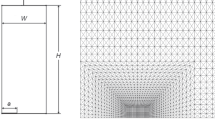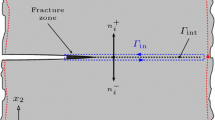Abstract
A semi-infinite-crack model is used to supplement the conic section simulation method for determining stress intensity factors of finite cracked bodies under mode I loadings. The actual displaced crack surface profile is found by finite element analysis. For each crack surface segment between two neighbouring nodes, a set of model parameters is found by using the displacements of these two nodes. A stress intensity factor estimate is then calculated from the closed-form formula associated with the model. It is found that near-tip crack surface displacements produce model parameters that are sufficient for quantifying the stress intensity factor. The semi-infinite-crack model can be used either as a stand alone model or in conjunction with the ellipse simulation procedure to form a systematic approach. It is shown that this model can be applied to different geometries and loadings with excellent accuracy.
Similar content being viewed by others
References
B. Gross and J.E. Srawley, ‘Stress-intensity factors for single-edge-notch specimens in bending or combined bending and tension by boundary collocation of a stress function’, NASA TN D-2603 (1965).
M.L. Williams, Journal of Applied Mechanics 19 (1952) 526–528.
N.I. Muskhelishvili, Some Basic Problems of the Mathematical Theory of Elasticity, Noordhoof, Leyden (1953).
J.C. Newman, ‘An improved method of collocation for the stress analysis of cracked plates with various shaped boundaries’, NASA TN D-6376 (1971).
S.K. Chan, I.S. Tuba and W.K. Wilson, Engineering Fracture Mechanics 2 (1970) 1–17.
D.F. Mowbray, Engineering Fracture Mechanics 2 (1970) 173–176.
D.J. Hayes, International Journal of Fracture 8 (1972) 157–165.
D.M. Parks, International Journal of Fracture 10 (1974) 478–502.
R.S. Barsoum, International Journal of Fracture 10 (1974) RCR 603–605.
P.P. Lynn and A.R. Ingraffea, International Journal of Numerical Methods in Engineering 12 (1978) 1031–1036.
L. Banks-Sills and D. Sherman, International Journal of Fracture 32 (1986) 127–140.
I.L. Lim, I.W. Johnston and S.K. Choi, International Journal of Fracture 58 (1992) 193–210.
H.L.J. Pang, Engineering Fracture Mechanics 44 (1993) 741–751.
K.L. Chen and S.N. Atluri, Engineering Fracture Mechanics 36 (1990) 327–340.
C.L. Chow and K.J. Lau, International Journal of Fracture 12 (1976) 669–684.
W.L. Chan, ‘A weight-function approach for determining stress intensity factors in isotropic and orthotropic plates using finite element analysis’, MPhil thesis, Department of Mechanical and Marine Engineering, Hong Kong Polytechnic (1993) 40–42.
M. Isida, International Journal of Fracture Mechanics 7 (1971) 301–316.
J.E. Srawley and B. Gross, ‘Side-cracked plates subject to combined direct and bending forces’, Cracks and Fracture, ASTM STP 601 (1976) 559–579.
H. Tada, P.C. Paris and G.R. Irwin, The Stress Analysis of Cracks Handbook, Del Research Corporation (1985) 3.7a.
G.J. Lastman and N.K. Sinha, Microcomputer-based Numerical Methods for Science and Engineering, Saunders College Publishing (1989) 106–111.
O.L. Bowie, in Methods of Analysis of Crack Problems 1972, Volume 1, Noordhoof, Leyden (1972) 1–55.
Y.H. Wang, Y.K. Cheung and C.W. Woo, International Journal of Fracture 43 (1990) 97–108.
I.L. Lim, I.W. Johnston and S.K. Choi, Engineering Fracture Mechanics 44 (1993) 363–382.
IMSL Math/Library: Fortran Subroutines for Mathematical Applications, Volume 2, Visual Numerics Inc, (1994).
H. William, Numerical Recipes in FORTRAN: The Art of Scientific Computing, 2nd edn. Cambridge University Press (1992).
Author information
Authors and Affiliations
Rights and permissions
About this article
Cite this article
Ng, S.W., Lau, K.J. A semi-infinite-crack model for determining mode I stress intensity factors using crack surface displacements. Int J Fract 76, 355–371 (1996). https://doi.org/10.1007/BF00039783
Received:
Accepted:
Published:
Issue Date:
DOI: https://doi.org/10.1007/BF00039783




